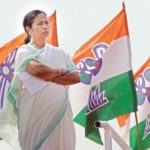West Bengal (WB) is the third-largest state in India, with 42 seats in the Lok Sabha after Uttar Pradesh (UP) and Maharashtra, which have 80 and 48 seats, respectively, in the lower house of India’s parliament.
West Bengal is also a state that has witnessed political stability and a system of rule by one dominant party over the last four decades. Such stability and party dominance was not provided by any of the big national parties, such as the Indian National Congress (INC) or the Bharatiya Janata Party (BJP), but instead by the smaller national parties and regional players – first by the Left Front (led by the Communist Party of India (Marxist) [(CPI)M]) from 1977 to 2011 and then by the Trinamool Congress from 2011 onwards.
The Trinamool was a state party from 1998 to 2016. Since September 2016, the All India Trinamool Congress (AITC) has been recognised as the seventh national party by the Election Commission of India (ECI) along with the BJP, the Bahujan Samaj Party (BSP), the CPI(M), the CPI, the INC and the Nationalist Congress Party (NCP).
In the run-up to the Lok Sabha elections of 2019, a new AITC logo has been showcased in propaganda campaigns, posters and party manifestos. The new logo focusses on the single word ‘Trinamool’ (meaning grassroots) and drops the word ‘Congress’ – even though the party is still registered as AITC with the ECI. Thus, two decades after the original split from the INC, the Trinamool has consciously and symbolically distanced itself from its parent party.
Over the last four decades, the big national parties have been unable to have any major impact in West Bengal. In fact, from the 1998 Lok Sabha election onwards and in all subsequent parliamentary and assembly elections, the big national parties have always been relegated to third or fourth place in terms of vote share.
Ever since the late 1990s, the main political battle has been fought between the CPI(M)-led Left Front and the Trinamool. In this respect, West Bengal is very similar to politics in Tamil Nadu (TN), where the big national parties have been marginal players in the state for almost five decades.
The story of political stability in West Bengal anchored by small national parties has effectively led to a different electoral system operating there that has been mostly immune to the political appeal of the big national parties. The consolidation of the Trinamool in the state has been taking place since 2009, with increasing levels of support for the party in successive elections (see Table 1 below).
Table 1: Vote Share and Seat Share of the Trinamool in West Bengal, 2009–2016

LS: Lok Sabha; VS: Vidhan Sabha; Source: Election Commission of India
In the 2014 Lok Sabha elections in West Bengal, for the first time, the Trinamool contested without being an alliance partner of either the BJP or the Congress and won 34 of the 42 seats. The Trinamool achieved its success with a regionalist agenda and without being part of any major political alliance.
The trend of increasing support from the poor and the Muslims for the Trinamool can be noticed in the 2016 assembly election. According to the Centre for the Study of Developing Societies (CSDS) post-poll survey data for 2016, the Trinamool was able to increase its support base among the poor from 21 per cent in 2006 to 52 per cent in 2016. Similarly, among Muslims, it enhanced its support from 22 per cent in 2006 and 35 per cent in 2011 to 40 per cent in 2014 and 51 per cent in 2016.
Moreover, the popularity of Chief Minister Mamata Banerjee among significant sections of the electorate and the increasing support of women voters (as high as 48 per cent in the 2016 assembly election) have been essential factors for the consolidation of the Trinamool. Keeping an eye on the increasing support of women for the party, the Trinamool has also fielded 41 per cent of women candidates in West Bengal for the 2019 Lok Sabha elections.
The Trinamool-led West Bengal government has been giving various kinds of assistance to the poor, among which four welfare schemes have ensured high levels of popular support: Khadyasathi (rice and wheat at INR 2 per kilogram), Sabooj Sathi (free bicycles for schoolchildren), Kanyashree (cash incentives to girls for continuing school education) and Yubashree (financial assistance to unemployed youth).
In the context of an impending agrarian crisis in rural Bengal and farmer indebtedness, these welfare schemes have ensured a solid rural support base for the Trinamool. Such government assistance has helped the Trinamool to manage considerable sections of non-corporate capital and the informal sector labour force.
Moreover, the CSDS 2016 post-poll survey suggests that voters think the performance of the Trinamool-led government has been much better than that of the Left Front in three respects: the condition of the roads, the electricity supply, and the supply of drinking water. My own fieldwork in South 24 Parganas, Malda and Burdwan districts between 2014 and 2018 likewise found that people are satisfied with these visible developments.
Today, the Trinamool has transformed itself from being a party articulating a centre-right political agenda as during its proximity to the BJP in the 1998–2006 phase into a party and leader espousing centre-left populist politics, dating back to the Singur agitation following the 2006 assembly election. The Trinamool’s hands-off policy on Special Economic Zones (SEZ) and land acquisition as well as its opposition to foreign direct investment (FDI) in retail, demonetisation and the rapid implementation of the Goods and Services Tax (GST) all indicate that the party’s main focus is on its prime constituency in the informal sector.
Simultaneously, the Trinamool’s anti-centre politics – demanding more powers for the state, opposing the centre’s decision to cut interest rates for bank savings schemes, and also opposing the delay in funds being disbursed by the central government for several welfare schemes – has plenty of traction among the electorate of West Bengal.
In the 2019 Lok Sabha elections, the Trinamool as a regional party aims to play a decisive role in the formation of an alternative government at the centre. It has the precedent of the Left playing such a role in the Lok Sabha elections in 1989, 1996 and 2004.
The political articulation of regional populist parties with a federalist orientation is one among several possibilities for a new political discourse in twenty-first century India, as I have argued in the epilogue to my recent book. However, we shall have to wait until 23 May 2019 to see whether the Trinamool’s objective to form an alternative national government at the centre comes true.
Maidul Islam is an Assistant Professor of Political Science at the Centre for Studies in Social Sciences, Calcutta, India. He is the author of Limits of Islamism: Jamaat-e-Islami in Contemporary India and Bangladesh and Indian Muslim(s) after Liberalization.
Image Credit: Millennium Post.
*Articles published by The Asia Dialogue represent the views of the author(s) and not necessarily those of The Asia Dialogue or affiliated institutions.



